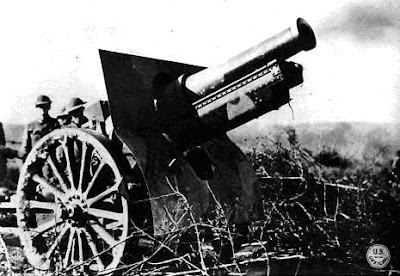
By:
Henry Wood
United Press Staff Correspondent
August 16, 1916
With the French Armies on the Somme. A thirty mile horseshoe of solid artillery fire, one of the most terrific shell blasting in the history of the world, is drawing a line of flame along the Somme battlefield
The artillery reached its greatest intensity as I arrived at the highest point on Dom Pierre plateau, southwest of Peronne. The day before the French had captured German third line positions from Hardecourt to Buscourt. At the precise moment of my arrival the French were employing all their great artillery strength to protect their newly acquired positions. The Germans were shelling even more desperately in an effort to dislodge the French and launch counter attacks.
The stupendousness of this great artillery struggle was indescrible. The curving line of fire extended from the French positions before Clery, north of the Somme, to St. Quentin, thence south to the region of Peronne. Shells of all calibers, both shrapnel and high explosives burst at every instant at every point along the entire front. With a rapidity which defied counting. For one lone interval, by a seemingly miraculous intervention. I was able to count off fifteen seconds when not a single shell exploded. Immediately thereafter, the tide was resumed with redoubled intensity.

Equally impressive as this thirty mile unbroken circle of artillery fire, was the thirty mile horse shoe of French observation sausage balloons over hanging at a great height the entire battle front. Their wireless instruments were directing the French fire.

At the same time innumerable French aero planes darted in and out among the sausages, crossing and recrossing the German lines every minute. From time to time as a daring aviator flew over the German positions half a dozen white puffs would suddenly appear with startling distinctiveness silhouetted against the clear blue sky, showing where the German anti aircraft gunners had sought to encircle the aero plane with shrapnel.
Yet despite this great activity of Frances air forces, not a single German aero plane appeared either for the purpose of chasing back the French, attacking the French sausages or for reconnoitering. Likewise not a single German sausage was visible to offset the unbroken thirty-mile semi circle of twenty six French sausages which I was able to count.


